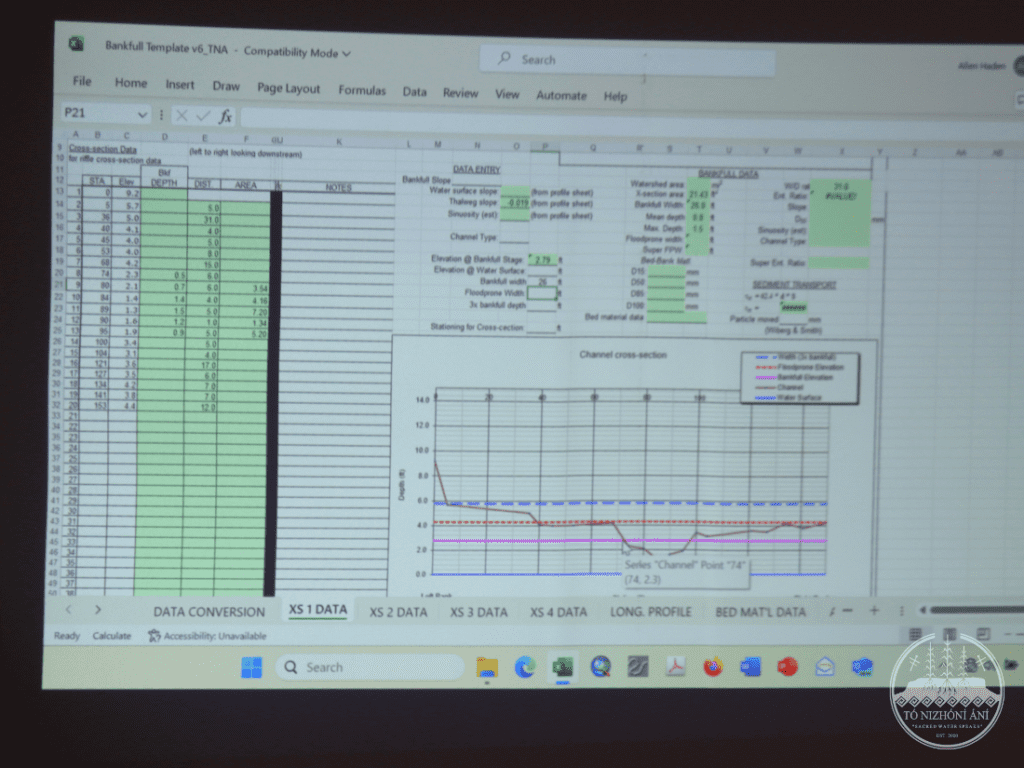Tsiyi’ Tó Watershed Project/Training Assessment Week


The Watershed Restoration campaign at Tó Nizhóní Ání has begun! In partnership with Natural Channel Design Engineering Inc., our campaign began phase one of the pilot project in the Tsiyi’ Tó Wash watershed in Hardrock, Arizona. Tsiyi’ Tó means “within the wooded area, there is water.” We are excited to begin this work for its importance in rangeland restoration, farmland rewetting, erosion control and aquifer recharge. Nestled in the upland mountainous region of Dził Yijiin (Black Mesa), the Tsiyi’ Tó Wash watershed (a tributary to Oraibi Wash) is the ideal proving ground and classroom to display impactful and resourceful nature-based restoration practices. A tributary to Oraibi Wash, a contributor to the streamflow of the Lower Colorado River – this work is, now more than ever – needed and necessary. Desertification is quickly engulfing our lands; our goal is to bring more moisture back to Black Mesa.

Our team spent June 18 through June 21 learning and assessing a watershed from the fundamentals to applicable skills in the field. The first day was indoors where we gained a scientific and quantitative approach to watershed restoration from a presentation by Natural Channel Design Engineering. Trainees included members from the Food Sovereignty campaign, Sliding Rock Farm and the Black Mesa/Kits’iilí Chapter. Our knowledge of the land was combined with the perspective of an engineer to portray the greatest impact and how to stabilize a natural channel. This sets our mindset for what to look for during the field workdays.

The second day contained a half day in the field, then wrapping up indoors to beat the heat of the afternoon. Trainees traversed rugged terrain to get to the upper reaches of the Tsiyi’ Tó Wash. The morning air, crisp but warm, lingered as trainees measured the various aspects of a stable natural channel. Crosscut profiles, stream bed composition, Bank Erosion Hazard Index analysis, and elevation profiles of the stable channel were assessed with hands on learning from instructors. To put the measurements into perspective, the numbers gathered from the levels were inputted into an Excel spreadsheet to display a graph of the size and elevation loss of the wash. This data is important to gather to predict the way that the channel might react to surface flows.
Additionally, we walked and observed different examples of existing restoration practices in place. Nature is already stabilizing the channel in some very incised areas. While erosion may look extreme, meandering channels have allowed for more stabilization in the wash. Plug and Spread examples were observed and discussions on best practices were constant throughout our walks in the watershed.

On our third day of assessment, we regrouped at the top of Tsiyi’ Tó Wash where the stable channel started and walked in three separate groups to get the most comprehensive analysis of the Tsiyi’ Tó Wash. One group was on the east side of the wash, another group was inside of the channel, and the third group was on the west side of the wash. Each group was responsible for measuring the head cut depth on their side of the wash and taking geotagged photos of where these head cuts are happening. Trainees discussed with instructors on potential ways to fix various levels of erosion, from small washes to incised head cuts. The monsoon storms drove us inside and the land gathered moisture as a quick storm rolled on top of us.
Our last day consisted of a watershed walk near the top of a ridgeline where different types of slopes and gradients can be observed. These watershed areas are important because they feed directly into a wash, a water crossing during high precipitation. Again, we broke into two different groups to assess the vast landscape.
“It has been inspiring to work with TNA and the Black Mesa community to begin planning and implementing a watershed restoration project on Black Mesa. There is a lifetime of work to be done in these watersheds, today is only the beginning. We are grateful to work with the community to share our knowledge and learn from the local community. My goal is to build the capacity for this work to continue through future generations, as it has for time immemorial.”
Sam Ebright, Natural Channel Design Engineering, Inc.

This work is important to initiate and continue because so much of the land is changing due to climate change. “We need to stop looking at what our neighbors are doing and how many horses or sheep they need to have,” said Nicole Horseherder, Executive Director of Tó Nizhóní Ání. “We need to stop being concerned only with increasing livestock numbers and start looking at what we can to do to restore the watershed and the riparian areas.”
Phase one, assessment, is complete and the next phase will include gathering materials to build the structures. Some structures will be large and sit inside of the wash, while others will reduce stream flow velocity and promote recharge of the aquifers below. “From my perspective, erosion is terrible for the land, and it is sad to see that we have not put that much effort into preserving and cherishing our land,” said Ian Simonson, watershed project trainee. “The Watershed Restoration Training has taught me many new things that I am hoping to teach the younger generations. It is hard work what we are trying to do but overall, it will pay off.”
Thank you to the original landlords and stewards of the land we call Black Mesa allowing us to use the land as a pilot project example. Thank you to the cooks and the host for which we were able to sustain ourselves and find shelter during warm weather. For more information about this watershed campaign and ways to support this vital work on Black Mesa, contact Andrew@tonizhoniani.org.











